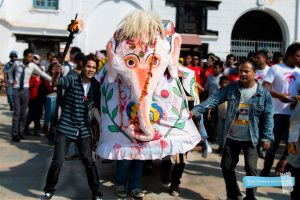
Ever heard of a festival where giant chariots roll through the streets, a 70-foot pole gets pulled down, and thousands of people come together to celebrate the slaying of mythical snakes? That’s Bisket Jatra for you—an epic celebration held every year in Bhaktapur, Nepal. And trust me, it’s nothing short of wild.
The Story Behind Bisket Jatra
So, here’s where it all began—with a pretty creepy legend. A princess kept losing her husbands—like, every guy she married was found dead the next morning. Nobody could figure out why.
Then came a brave prince. Before entering Bhaktapur, he met Goddess Bhadrakali, who told him the shocking truth. Apparently, two evil snakes came out of the princess’s nose while she slept and strangled her lovers. Yeah, not exactly bedtime story material.
The prince married the princess, waited for her to fall asleep, and saw it happen with his own eyes. The snakes slithered out of her nostrils. Without hesitating, he pulled out his sword and killed them on the spot.
When morning came, the whole city celebrated. To mark the occasion, the people of Bhaktapur began Bisket Jatra—a festival that still rocks the town today.
Why the Giant Pole (Yoshin) Matters
One of the festival’s biggest highlights? A giant wooden pole known as Yoshin. This thing is 70 feet tall and raised in a huge open area near the Hanumante River.
But the story of this pole is just as dramatic. A group of men go into the forest with a goat (yes, a goat). The tree the goat rubs against gets picked. That goat? Sacrificed right then and there. Brutal but symbolic.
The chosen tree is chopped down and turned into the Yoshin pole. It represents the snakes from the legend—and when it’s raised, it’s a huge moment for the crowd. The real party kicks off when the pole is pulled down again on Nepali New Year’s Day.
Meet the Main Gods: Bhairav and Bhadrakali

Bisket Jatra isn’t just about legends—it’s also deeply religious. The festival honors two powerful deities: Bhairav, the fierce god of destruction, and Bhadrakali, his equally intense consort.
These gods live in special “god houses” in Bhaktapur—not your regular temples. They’re so sacred that only specific priests can enter. Many of the rituals here are rooted in tantric practices, and honestly, a lot of it is kept secret. It’s part of what makes the festival so mystical and intriguing.
One wild tale says Kaasi Bhairav, a form of Bhairav, once visited Bhaktapur. A tantric expert recognized him and tried to trap him using magic. As Bhairav tried to escape into the ground, Bhadrakali stepped in and ordered his head to be cut off. That’s why the Bhairav idol is just a head—and it’s kept in Bhairavnath temple today.
Let’s Talk Chariots and Chaos
Now for the fun part—the chariots. Two massive wooden chariots are built: one for Bhairav and another, slightly smaller, for Bhadrakali. These aren’t just for show. Locals gather to pull these chariots through the narrow streets of Bhaktapur in a full-blown tug-of-war battle.
It’s absolute mayhem—in the best way possible.
Different parts of town pull the chariots in opposite directions. There’s shouting, cheering, tugging, and sometimes even fighting. But it’s all part of the tradition, and it brings the community together like nothing else.
Why This Festival Is So Unique
Bisket Jatra stands out from all other festivals in Nepal. It blends legend, ritual, and pure street energy into a once-in-a-lifetime experience.
Everyone in town plays a role—carpenters, painters, oil pressers, priests. There’s even a government official who shows up from Kathmandu carrying a ceremonial sword passed down from the old Malla kings. That sword is used during the rituals, keeping history alive right in the middle of all the action.
The chariots, the pole, the serpent story, the secret tantric rituals—this festival has it all. And even though it’s rooted in ancient tradition, it still feels alive, raw, and totally unforgettable.
Conclusion
Bisket Jatra isn’t just a celebration—it’s a living legend. It brings a whole city together through wild stories, sacred rituals, and high-energy chaos that you won’t see anywhere else.
If you’re ever in Nepal in April, do yourself a favor: make your way to Bhaktapur. Stand among the crowd. Watch the chariots roll by. Feel the rumble as the Yoshin pole comes crashing down. You’ll never forget it.



